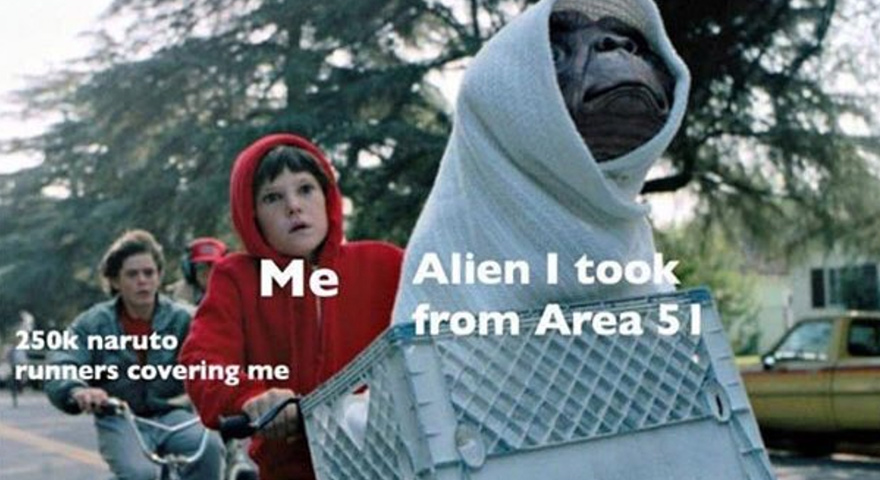By Gaia Santoro Lecchini
In June 2019, Matty Roberts, a 21-year-old college student, began a movement to raid Area 51. What originally started as a joke took the internet by storm (no pun intended). Bored one night, Roberts shared a scheme to a public Facebook group. His mission? To storm the highly classified United States Air Force base and “see them aliens.”
Many found Robert’s plan comedic. Memes around the raid dominated social media. People joked about what they would feed their new pet aliens. Some said they could dodge bullets if they “naruto ran,” an anime reference. Yet underlying this was genuine interest from conspiracy communities. Area 51 inspires a fear of mystery and collusion. Its secretive nature has put it at the forefront of many extraterrestrial conspiracy theories. Conspiracy theorists allege that the government is hiding Unidentified Flying Objects (UFOs) and aliens from the public in Area 51.
In the 1950s, the U.S. government covertly created Area 51 in southern Nevada. It was around this time that UFO sightings soared. People described usual unidentified saucers and lights. “No Trespassing” and “Warning” signs littered the boundaries of Area 51. Without any information on what was going on within the borders, suspicions rose.
The history and events that surrounded the area boosted Area 51’s suspect nature. For example, an incident that occurred some years before in the southwestern town of Roswell, New Mexico grew suspicion. In 1947 a rancher found and reported debris from a crash. The military took this material to an undisclosed location. The press later described the debris as the remains of a “flying saucer.” Officials maintained that it was in fact from a weather balloon. Conspiracy theorists jumped on this as a government cover-up.
It was also around this time that the Air Force was performing “dummy drops.” These tests measured how high-altitude parachute jumps would affect pilots. The procedure consisted of dropping human-like dummies from far up in the sky then swarming them with government cars and hauling them away. One might understand what impression these drops left on New Mexico locals.
With all this suspicious activity, it seemed highly dubious for a government facility to be placed nearby. Conspiracy theorists began to assume that this secretive base was built for the purpose of dealing with extraterrestrial life. Some speculated that officials took the crash and dummy drop debris to Area 51 for studying. That might well be true.
In 2013, the Central Intelligence Agency declared Area 51 a military base built as a test area for overhead surveillance technology. In other words, confidential military spy crafts. No wonder there was a spike in UFO sightings. But these were actually American-made flying objects rather than otherworldly creations.
For over six decades, however, the public had to explain the bizarre things they were seeing UFOs, falling human-like figures, and a secretive government. It was the perfect climate for conspiracy theories.
The effect has been the solidification of Area 51 as a central icon in alien conspiracy theories, science fiction, and pop culture. Movies like Zero Dark Thirty and Independence Day, both created before 2013, heavily feature Area 51 in connection with secret government operations and extraterrestrial life.
Now that most of the strange occurrences have been logically explained, why is there still suspicion surrounding Area 51?
Extraterrestrial conspiracy theories fit the mold of most conspiracy theories. One of the defining features of a conspiracy theory is they focus on those in power. It could be “Big Pharma” trying to take people’s hard-earned money. Maybe it’s the “Deep State” manipulating citizens and maintaining control. One can argue that alien conspiracies are strictly about there being alien life. Yet what is most often at their core is a distrust in government.
One of the key phrases in Matty Robert’s Facebook post was “They can’t stop all of us.” Yes, most people understand that the Area 51 Raid was a joke and not a historical coup. The incredibly low turnout, primarily made up of reporters, assisted in this perception. Yet to those involved in conspiracies, that phrase is a perfect conspiratorial call to action. Conspiracy theories summon a mobilization against “the powerful.” The Area 51 Raid was not only about discovering if aliens were indeed real. It was also about taking on the government and making it reveal the truth to the governed.
This idea comes from populism, a political movement where “the people” stress their voice over that of the “elites.” Many Americans remain skeptical of experts and government elites. Some believe that the influence of politics and profit muddy the central role of experts to provide the public with unfiltered and accurate information. This could explain the conspiracy theorists’ rejection of government’s and experts’ explanations surrounding Area 51. If this is the reality, challenging conspiracy theorists is left incredibly difficult.
Perhaps none of this matters and the failure of the Area 51 raid speaks to that. Yet the common perception of conspiracy theorists being a small, if vocal, minority is not wholly true. A recent Gallup Poll shows that one-third of Americans believe aliens have visited Earth. Sixty-eight percent believe that the U.S. government knows more about UFOs than it says.
Conspiracy theorists market their claims along populist lines. They advocate the people’s knowledge over the manipulative powerful. Why does it work? Might it be more satisfying to believe that one knows more than the government and elites wants them to rather than accept the bland truth? For some (or as it appears, for many), it is indeed.
